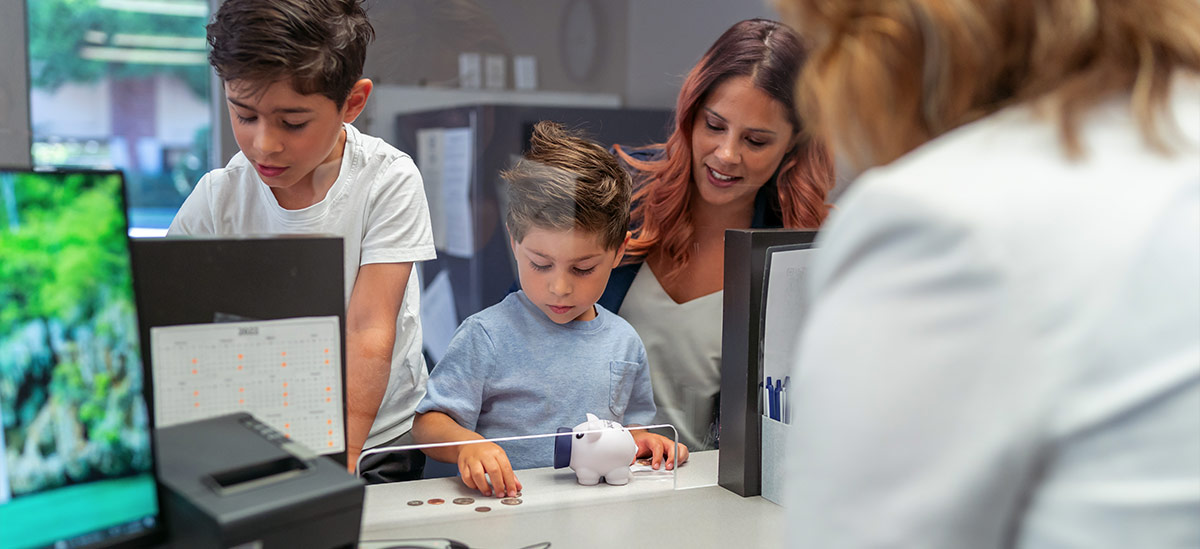
As a parent, you know how important it is to teach your children financial responsibility. A children’s savings account can help your child learn hands-on money management skills – such as budgeting and saving – from an early age.
Children's bank accounts also help teach financial concepts and grant some independence as your children learn how to manage funds. However, getting started may feel overwhelming for some busy moms and dads.
Wondering how to choose and open the right type of bank account? If so, you're not alone. We'll answer the most common questions about opening a savings account for a child, plus offer tips on how to effectively use it as a learning tool.
Reasons To Open a Child’s Savings Account
A bank account is more than just a place to hold a child’s money. It also helps build the financial skills that will prove critical as your child becomes an adult. Here are a few benefits of opening a savings account for your child.
1. Financial Literacy
Managing a bank account helps children learn important financial concepts related to income, expenses, budgeting, and savings. Having a bank account also helps children learn how banks work. It’s an opportunity to give them hands-on experience visiting a bank branch, making deposits, and banking online.
2. Independence
Checking their account balance and watching funds accumulate gives children a sense of ownership over finances. This can help them learn how to set savings goals and make spending decisions. Watching account balances grow may also encourage children to take on jobs or entrepreneurial endeavors, giving them a strong work ethic.
3. Responsibility
Carefully tracking their funds in a savings account can help teach children accountability. It’s also an excellent way to demonstrate the real-world impact of savings and spending decisions.
4. Security
Savings accounts are safer than keeping money in a piggy bank or under the mattress. Opening an account shows kids how to keep their money safe and can also be used as an opportunity to teach them about fraud risks.
What To Look For When Choosing an Account
Many banks offer savings accounts specifically designed for children under 18. They typically function similarly to other types of savings accounts, offering features such as interest on deposits, access to online banking, and an ATM card.
The primary difference is that parents have account oversight and control over the funds until the child reaches the age of majority (18 in many states). Children’s savings accounts may have low or no fees and low balance requirements, making saving easy without excessive expenses. When comparing your options, consider the following:
- FDIC Coverage: Like standard savings accounts for adults, a children’s bank account can be FIDC insured, offering protection for up to $250,000 in the case of bank failure[1]. Before opening a children's savings account, make sure it's FDIC-insured.
- Fees and Balance Requirements: Look for an account that can be opened with a small or no initial deposit, low or no monthly fees, and no minimum monthly balance requirements. This allows for cost-effective savings and helps you avoid fees that erode your child’s account balance.
- Interest on Balances: Look for an account that pays interest and pay attention to the current rate offerings to ensure you choose a competitive account.
- Educational Resources: Many children's accounts include interactive financial literacy games, goal trackers, and digital lessons focused on critical concepts such as budgeting, saving, and spending. This can turn a regular account into a powerful learning tool.
- Online and Mobile Banking Access: User-friendly, secure online banking and mobile apps allow kids, with parental controls, to view transaction histories, deposit funds, and check balances around the clock. Not only is this convenient, but it can also help children grow an understanding of financial concepts and feel a sense of ownership over their funds.
- ATM Cards: Providing an ATM card with withdrawal limits helps children gain independence while teaching them about responsible spending.
- Automated Transfers: Depending on your goals, you may want to choose an account that allows you to make automated deposits. This could be used for various purposes, such as transferring funds for completing weekly chores instead of giving your child cash.
It’s also important to understand what happens to the account once the child reaches the age of majority. This can vary from one bank to the next. The account may be converted into an adult’s savings account or remain a joint account until the owners make a change. Some banks may convert for free, while others may charge a fee. It’s helpful to consult with your bank to understand the process before opening a minor’s account.
What Is Typically Needed To Open an Account for a Child?
Since opening an account for a minor is a bit different from opening a standard savings account, it’s common for parents to feel some confusion about what documentation they’ll need to bring. While the requirements can vary from one financial institution to the next, you will typically need the following:
- Child’s Personal Identification: Be prepared to provide the child’s Social Security number and present at least one form of identification, such as your child’s Social Security card, birth certificate, passport, or medical records.
- Parent/Guardian Information: Since minor accounts require adult oversight, a parent or guardian will need to provide their Social Security number and identification, as well as basic contact information.
- Initial Deposit: While some children’s bank accounts do not require an initial deposit, others may require a small amount, often ranging from $25 to $100. You can check with your bank to find out how much you’ll need.
The process of opening a child’s bank account is fairly straightforward. Once you’ve provided the items listed above, the bank will prepare forms to sign. Some institutions may allow you to open the account online, while others require it done at a bank branch in person. While the institution may not require your child to be present, involving them in the experience can prove a beneficial part of the learning process.
Tips for Managing Your Child’s Account
Once your child’s account is open, you’ll have many opportunities to create educational experiences. It’s also important to maintain oversight of the account. This can help you ensure it receives the proper interest income and is not charged excessive fees. The following tips will help you effectively manage your child’s savings account.
1. Focus on Making Smart Financial Decisions
When your child wants to make a purchase or withdrawal, use it as an opportunity to discuss the tradeoffs between saving and spending. This creates a real-world scenario that can help them understand the potential impact of their decision. Explain how resisting spending temptations helps them meet exciting future goals.
2. Carefully Oversee the Account
Set clear expectations upfront about how and when account funds can be used. Monitor all account activity to prevent unauthorized transactions and keep an eye out for fees. If the account requires a minimum balance or limits the number of monthly transactions, keep track of these as well.
3. Celebrate Milestones
Saving should be fun! Help your child get excited by celebrating milestones like opening their first account, making an initial deposit, or meeting financial goals. You may even consider rewarding financial responsibility with a surprise like dinner out or concert tickets, positive reinforcement that’s likely to stick with them over the long term.
4. Involve Your Child in Banking Transactions
Help your children feel comfortable handling finances by bringing them with you to the bank or allowing them to watch you make online or mobile banking transactions. Review the monthly account statements together, explaining things like the source of deposits, how and when withdrawals were made, and the interest earned.
5. Create Age-Appropriate Learning Opportunities
If your child is young when they open their first bank account, they might understand simple concepts like checking the account balance and making decisions between saving and spending. Still, they may not be prepared for complex explanations. As they age, look for opportunities to discuss more complex financial matters such as compounding interest, the impact of income taxes, and the potential dangers of accumulating debt. Keep in mind that your child's bank account offers an opportunity to strategically nurture financial skills over time.
Explore PNC Bank’s Child Savings Account
Opening a children’s savings account allows your child to get real-world, hands-on experience to help them become financially responsible adults. As you explore options, consider PNC Bank’s S is for Savings® account – an account designed specifically for kids. With an interactive online banking experience, interest on balances as low as $1.00, and an auto savings feature, it provides parents with all the tools they need to introduce their children to the exciting world of savings.
The Learning Center provides children with financial tips from Sesame Workshop and fun activities that parents and children can do together.
With no minimum opening deposit required, the S is for Savings® account is an easy way to offer your child an enjoyable head start to their financial education. Get started today!







